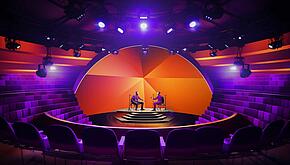- Why Us?
- Features
White Label
For SaaS Platforms & Agencies
Provide our complete analytics suite to your clients, directly within your own interface and with your/their own branding. Discover Analytics-as-a-Service and White Label Analytics. Great benefit, minimal effort.
- Pricing
- White Label
- Success Stories
- Partner
- ResourcesExpand Your Knowledge

Simon Coulthard July 01, 2022
2 min
What is Virtual Reality Marketing?

VR marketing is all the rage these days; it benefits companies by providing customers and prospects with an immersive and engaging experience that has a real bearing on sales.
But if you’re reading this, you’re probably wondering what virtual reality marketing is, and how it can be integrated into your marketing strategy.
This article has answers to these questions, so read on and learn about this fascinating future technology that is finally starting to show its potential.
What is Virtual Reality?
Virtual Reality is a fully immersive digital experience that completely blocks out the real world.
It’s a fairly old concept, having been prophesied back in the 1930s, and computer games companies were building headsets in the 1990s. Virtual Reality has had quite a few false dawns over the years, but we’ve finally reached the point where this technology is now a viable product on the open market.
To access virtual reality worlds, all people need is a virtual reality headset, though other devices are multi-sensory and come with gloves and other body sensors.
In the past, cost was the issue that put people off. However, VR devices have been getting steadily cheaper over the years. And, with today’s huge market for electronic goods, the prices for virtual reality equipment don’t look out of place given how much people are prepared to pay for, say, a Playstation, drone or hoverboard.
And, while the devices are expensive, big companies like Google, Facebook and Sony are all investing huge sums of money in VR headsets. Today, prices range from around $20 for the Google Cardboard, to thousands of dollars for more expensive options.
It’s also something people want, with the global consumer VR market hitting $3.7 billion in 2021 (Statista). A great many of these users are gamers, but this has long been a trailblazing industry for new technologies that later become popular with a wider audience.
It’s Virtual Reality, Not Augmented Reality!
Somewhat confusingly, when people talk about virtual reality marketing, they often mean augmented reality instead, or a combination of the two.
Augmented reality (AR) is not as immersive as virtual reality, and refers to computer generated images and sound that are superimposed over the real world. You’ve no doubt had some experience of it, or have heard of it, with snapchat filters and Pokémon Go both prominent examples.
Indeed, AR marketing is far more common than its VR equivalent, mainly because people only need a smartphone with a working camera to operate it. It’s also less costly than VR, making it a more feasible option for companies.
But we won’t worry about augmented reality here - partly for simplicity, and partly because we’ve covered this subject extensively elsewhere.
How is Virtual Reality Used in Marketing?
As the title of this article suggests, virtual reality marketing is all about integrating VR technology into your marketing strategy.
And, as far as VR content is concerned, the sky’s the limit - from virtual tours to interactive experiences with 3D models, ripping your brand out of its 2D prison and driving engagement.
Virtual Reality Examples in Marketing
Below are some examples of how virtual reality is being used in marketing:
Retail
Retail was one of the earliest adopters of virtual reality marketing because of the way it enables customers to “try before they buy”. They can walk around virtual stores, pick out whatever clothes or beauty products - from sunglasses to clothes - and see what these products would look like on them.
Real Estate
Potential homeowners and tenants can put on their VR headsets and enjoy digital walkthroughs of properties - regardless of where they are in the world.
These experiences are more detailed than you might think - people can enter the spaces, measure the scale of rooms and determine the exact size and finishes of the different rooms.
Property agents can do these in one of two ways - either by recording a walk-through or 360 video promoting the property, which they can show to any many people as they like, or an interactive visit, in which clients can choose how to move around the property and what they do inside.
Travel
The most common way that VR is used by the tourism industry is in marketing, and it is easy to see why!
One of the main strengths of this technology is how it can make users feel like they are actually there - provoking more of an emotional attachment to locations than can be provided by normal images and videos.
Consumers can digitally visit any locations that they are considering, and can use the VR experience to decide where to go and what to do when they’re there.
Hospitality
Hotels and restaurants with event spaces can leverage VR technology so that customers and organizers can form a realistic idea of how their events would look like in a particular space - an attractive option for people who might not be able to visit everywhere in real life as they decide which location to go for.
Seen in this way, VR technology brings real benefits to the businesses in the hospitality sector, and is a great way to drive additional sales.
Automobile
Car companies can leverage VR technology to enable prospects to test drive their vehicles.
And while this doesn’t quite allow customers to know what the car feels like, VR marketing enables companies to reach out to people who live too far to see the vehicle for themselves.
People are able to walk around a digital VR-powered showroom, and select, customize and test drive a vehicle, all from the comfort of their living rooms.
Virtual drives are also a great way to associate a car with exciting experiences within a fully immersive 360-degree landscape, which is great for brand identity.
Want to Learn More About VR Marketing?
Now that you’ve got to grips with the basics, why not have a read through our Digital Futures hub?
This information portal goes into more depth about extended reality technologies like VR, and explains how marketers can future-proof their campaigns, while creating engaging content for customers.
Share article
Get Started for Free
Gain World-Class Insights & Offer Innovative Privacy & Security

You might also like
How is Blockchain Used in Marketing? 01 July 2022 - by Simon Coulthard
01 July 2022 - by Simon Coulthard
Why is Live Streaming Good for Marketing? 15 April 2022 - by Simon Coulthard
15 April 2022 - by Simon Coulthard










